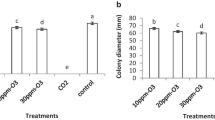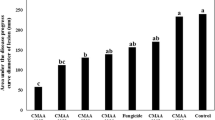Abstract
Antagonistic activity of the mixtures Rahnella aquatilis–Rhodotorula glutinis and R. aquatilis–Cryptococcus laurentii was assessed against Penicillium expansum (cause of blue rot) and Botrytis cinerea (cause of grey rot) on apple fruit at 4 °C and 95% relative humidity (RH). Under these cold-storage conditions, the mixture R. aquatilis–R. glutinis inhibited the development of B. cinerea and P. expansum in apples stored for 40 days and reduced the incidence of disease produced by these moulds to nearly zero. The other mixture, R. aquatilis–C. laurentii, was less effective; the incidences of the grey rot and the blue rot were about 25% and 15%, respectively. Population dynamics of the mixtures showed that the growth of R. aquatilis was strongly stimulated by the presence of the yeast R. glutinis, but in the case of the mixture R. aquatilis–C. laurentii, the same effect could not be observed. In this study, it was demonstrated that the combination of two microorganisms with different requirements and antagonistic abilities resulted in a successful mixture against the two pathogen molds, B. cinerea and P. expansum. In addition, it was also proved that it is possible to improve the biocontrol of these pathogens without increasing the inoculum size of the antagonist (alone or in mixtures), which was always 106cell/ml, despite the high concentration of the pathogen (106 conidia/ml) utilized.




Similar content being viewed by others
References
Calvente, V., Benuzzi, D., Obuchowicz, N., Hough, G., & Sanz de Tosetti, M. I. (1999). Changes in surface microflora of apple and pear fruits by application of pesticides and their relation with bicontrol of post-harvest diseases. Agro-food-Industry Hi Tech Italy, 10, 30–33.
Calvo, J., Calvente, V., Orellano, M. E., Benuzzi, D., & Sanz, M. I. (2003). Biological control of postharvest diseases of apples by yeast mixtures. BioControl, 48, 579–593. doi:10.1023/A:1025738811204.
Calvo, J., Calvente, V., de Orellano, M. E., Benuzzi, D., & Sanz, M. I. (2007). Biological control of postharvest spoilage by Penicillium expansum and Botrytis cinerea in apple by the bacterium Rahnella aquatilis. International Journal of Food Microbiology, 113, 251–257.
Cavalcante, R., Lima, H., Pinto, G., Gava, C., & Rodrigues, S. (2008). Effect of moisture on Trichoderma conidia production on corn and wheat bran by solid state Fermentation. Food Bioprocess Technol. 1, 100–104 doi:10.1007/s11947-007-0034-x.
Conway, W., Janisiewicz, W., Leverentz, B., Safner, R., & Camp, M. (2007). Control of blue mold of apple by combining controlled atmosphere, an antagonist mixture, and sodium bicarbonate. Postharvest Biology and Technology, 45, 326–332. doi:10.1016/j.postharvbio.2007.03.005.
Conway, W., Leverentz, B., Janisiewicz, W., Safner, R., & Camp, M. (2005). Improving biocontrol using antagonist mixtures with heat and/or sodium bicarbonate to control postharvest decay of apple fruit. Postharvest Biology and Technology, 36, 235–244.
Goepfert, J. M. (1980). Verduras, hortalizas, frutas, frutos secos y sus productos. ch.21. In:Ecología Microbiana de los Alimentos,Vol II. Ed. Acribia, Zaragoza, España 335–338.
Guetsky, R., Shtienberg, D., Elad, Y., Fisher, E., & Dinoor, A. (2002). Improving Biological control by combining biocontrol agents each with several mechanisms of disease suppression. Phytopathology, 92, 976–985. doi:10.1094/PHYTO.2002.92.9.976.
Janisiewicz, W. (1996). Ecological diversity, niche overlap, and coexistence of antagonists used in developing mixtures for biocontrol of postharvest diseases of apples. Biological Control, 86, 473–479.
Janisiewicz, W., & Bors, B. (1995). Development of a microbial community of bacterial and yeast antagonists to control wound invading postharvest pathogens of fruits. Applied and Environmental Microbiology, 61, 3261–3267.
Nunes, C., Usall, J., Teixido, N., Torres, R., & Vinas, I. (2002). Control of Penicillium expansum and Botrytis cinerea on apples and pears with the combination of Candida sake and Pantoea agglomerans. Journal of Food Protection, 65, 178–184.
Spadaro, D., & Gullino, M. L. (2005). Improving the efficacy of biocontrol agents against soil borne pathogens. Crop protection, 24, 601–613. doi:10.1016/j.cropro.2004.11.003.
Acknowledgments
We thank Juan Carlos Soloa for his technical assistance. Financial support from Universidad Nacional de San Luis, Argentina, is gratefully acknowledged.
Author information
Authors and Affiliations
Corresponding author
Rights and permissions
About this article
Cite this article
Calvo, J., Calvente, V., Orellano, M.E. et al. Control of Penicillium Expansum and Botrytis Cinerea on Apple Fruit by Mixtures of Bacteria and Yeast. Food Bioprocess Technol 3, 644–650 (2010). https://doi.org/10.1007/s11947-008-0139-x
Received:
Accepted:
Published:
Issue Date:
DOI: https://doi.org/10.1007/s11947-008-0139-x




